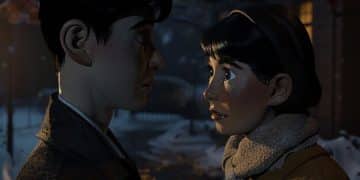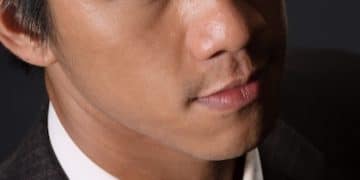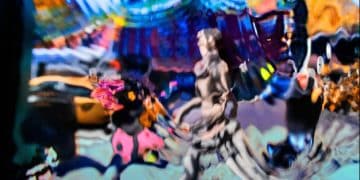K-Drama Historical Accuracy: Fact vs. Fiction in Period Dramas
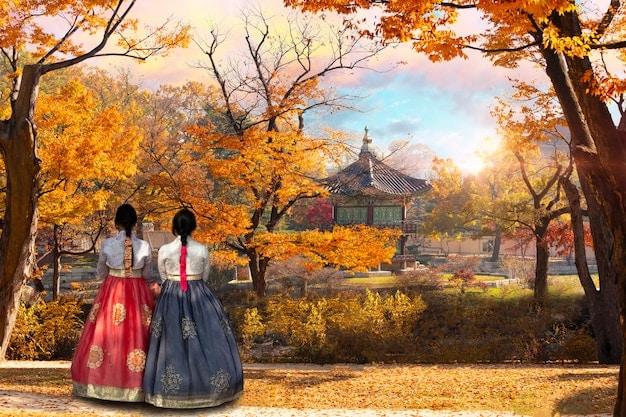
Striking a delicate balance, K-dramas often weave compelling narratives by blending historical events with fictional elements, creating an immersive experience that entertains while offering glimpses into Korea’s rich past, albeit with artistic liberties.
Delving into the captivating world of Korean historical dramas, one question frequently arises for viewers: just how accurate are these meticulously crafted productions? Exploring K-Drama historical accuracy: separating fact from fiction in period dramas is a fascinating journey, allowing us to appreciate the artistic license taken while gaining a deeper understanding of Korea’s rich past.
Understanding the Genre: Entertainment First, Education Second
Korean historical dramas, or
The allure of
The Spectrum of Accuracy: From Loosely Inspired to Deeply Researched
Not all historical K-dramas are created equal in their approach to facts. Some might use a specific historical event as a mere backdrop for an entirely fictional love story, while others meticulously research period details, costumes, and political landscapes. It’s a spectrum, ranging from dramas that are loosely inspired by historical events to those that strive for a high degree of authenticity.
- Fictionalized Narratives: Many dramas take real historical figures but craft entirely new personal lives or political conflicts around them (e.g., intense romantic storylines).
- Artistic License: Events might be condensed, characters merged, or timelines altered to fit the dramatic arc, simplifying complex historical processes for easier consumption.
- Anachronisms: Occasionally, elements (dialogue, technology, social norms) that don’t belong to the depicted era might slip in, sometimes intentionally for humor or relatability.
The creators often face a dilemma: how to balance the need for commercial success with the desire to present a historically resonant narrative. This balance often leans towards storytelling that resonates with contemporary audiences, even if it means bending historical conventions.
Key Areas of Artistic Embellishment in K-Dramas
When analyzing K-drama historical accuracy, several recurring areas show significant artistic embellishment. Recognizing these patterns helps viewers discern fact from fiction and appreciate the creative liberty taken by writers and directors.
One prominent area is character portrayal. While historical figures serve as anchors for the narrative, their personalities, relationships, and even their actual roles in history are frequently exaggerated or altered to create more compelling protagonists or antagonists. A benevolent king might become a tragic hero, or a cunning politician might be reimagined as a misunderstood genius. Such alterations contribute to the emotional depth of the drama, often at the expense of strict biographical accuracy.
Romantic Subplots: The Ever-Present Fictional Thread
Perhaps the most common deviation from history lies in the romantic subplots. History, particularly royal history, was often about strategic alliances and political marriages, not passionate love affairs between a monarch and a commoner, or intense rivalries for affection. K-dramas, however, thrive on these romantic narratives, making them central to the plot, regardless of historical precedent.
- Unlikely Pairings: Commoners falling in love with royalty, or enemies developing deep affections, are staple tropes that rarely have historical basis.
- Emotional Depth: These romances add an emotional layer that captivates audiences, transforming political figures into relatable individuals.
- Audience Appeal: Romantic tension and an emotional core are strong drivers of viewership and global popularity for K-dramas.
These romantic elements are not inherently bad; they serve a purpose in drawing viewers into the story and making the historical setting more engaging. However, they are almost always purely fictional additions.
Costumes and Settings: A Blend of Authenticity and Artistic Flair
The visual splendor of historical K-dramas is undeniable. The elaborate costumes, breathtaking palace settings, and meticulously designed props often leave viewers in awe. While immense effort goes into recreating the aesthetics of specific periods, even here, artistic license plays a significant role.
Costumes, for instance, are often designed to be visually striking and appealing to modern sensibilities. Colors might be more vibrant, fabrics more luxurious, and designs sometimes more elaborate than what was historically accurate, especially for everyday wear. While royal attire might adhere more closely to historical records, the clothing of commoners or even lower-ranking officials can vary, sometimes reflecting contemporary fashion trends or production budgets rather than genuine historical accuracy.

Architectural Liberties and Set Design
Similarly, the sets and architectural elements, though often based on historical structures, can undergo transformations. Palaces might be made grander, smaller residences more picturesque, and entire villages created to fit the dramatic narrative. While the overall architectural styles are typically consistent with the period, specific layouts or decorative details might be altered for cinematic effect or practical filming purposes.
- Aesthetic Enhancement: Sets are built to be visually stunning, sometimes prioritizing beauty over absolute historical exactitude.
- Practicality: Filming requirements and budget constraints often dictate the scale and detail of sets, leading to compromises.
- Reconstructions: Many historical buildings have been lost or altered, requiring educated guesswork and creative interpretation during reconstruction for drama sets.
Ultimately, the aim is to create an immersive world that feels authentic to the audience, even if it’s not a perfect historical replication. This visual richness is a key reason for the global appeal of these dramas.
The “What If” Scenarios: Speculation and Reinterpretation of History
Beyond simply adding romantic subplots, many historical K-dramas engage in “what if” scenarios, imagining alternative outcomes for well-known historical events or proposing different motivations for historical figures. This type of storytelling allows for creative freedom and can offer fresh perspectives on familiar narratives, but it fundamentally shifts the drama away from strict historical recounting.
For example, a drama might explore what would have happened if a certain political faction had prevailed, or if a specific historical betrayal had unfolded differently. These reinterpretations often serve to highlight specific themes, such as the struggles of the common people, the complexities of political power, or the sacrifices made for love and loyalty. While intriguing, these alternate histories should not be mistaken for factual historical accounts.
Philosophical and Social Themes Reflected Through History
K-dramas also frequently use historical settings to explore contemporary social and philosophical themes. Issues like gender inequality, class struggle, corruption, and the quest for justice, while present in historical contexts, are often amplified or recontextualized to resonate with a modern audience. This blend of past and present allows dramas to discuss relevant societal issues through the lens of history, making the narrative more impactful.
- Modern Lens: Historical events can be viewed through a contemporary moral compass, leading to different interpretations of characters’ actions.
- Social Commentary: Dramas often subtly (or overtly) critique present-day issues by depicting similar situations in the past.
- Relatability: Audiences can connect with characters facing universal struggles, even if the historical context is unfamiliar.
This reinterpretation makes the dramas more thought-provoking and relevant, encouraging viewers to consider historical events not just as static facts, but as dynamic narratives that can speak to current realities.
The Educational Byproduct: Learning Through Entertainment
Despite the liberties taken, historical K-dramas can still serve as an invaluable gateway to learning about Korean history and culture. For many international viewers, these dramas offer their first exposure to specific historical periods, figures, and traditional practices. While not always accurate in every detail, they spark curiosity and often encourage viewers to delve deeper into historical research on their own.
Viewers might encounter figures like King Sejong, Queen Seondeok, or Admiral Yi Sun-sin, and while their dramatic portrayals might be embellished, the dramas at least introduce their existence and their general historical significance. This initial exposure can then lead to further reading, documentary watching, or even visiting historical sites in Korea, transforming casual viewership into a genuine interest in Korean heritage.
Fostering Cultural Appreciation and Language Learning
Beyond history, these dramas are powerful tools for cultural diplomacy. They showcase traditional Korean architecture, cuisine, clothing (hanbok), music, and etiquette. This immersive experience helps viewers develop an appreciation for Korean culture, broadening their global perspective.
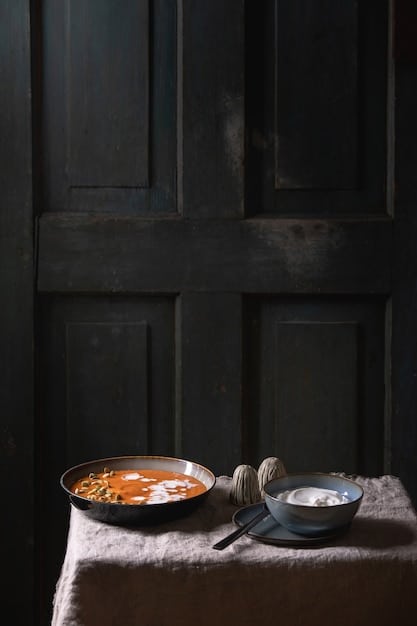
- Cultural Immersion: Viewers are exposed to a rich tapestry of Korean customs, traditions, and values.
- Language Exposure: Constant exposure to Korean dialogue, even with subtitles, aids in passive language learning and familiarization with Korean phonetics.
- Tourism Boost: Dramas have notably increased interest in Korean heritage sites and cultural tourism.
The cultural impact of historical K-dramas is undeniable, turning them into soft power instruments that promote Korea on a global scale. They are an enjoyable primer rather than a definitive historical text.
Navigating K-Drama Historical Accuracy: Tips for Viewers
For viewers keen on understanding the line between fact and fiction, there are several simple strategies to employ. Cultivating a discerning eye enhances the viewing experience, allowing for both enjoyment of the drama and an informed appreciation of its historical context.
Firstly, approach historical K-dramas with a healthy dose of skepticism, particularly regarding character relationships and highly dramatic events. Assume that most personal relationships, especially romantic ones, are fictionalized unless explicitly stated otherwise by historians. Remember that real history is often far more complex and nuanced than what can be portrayed in a few dozen episodes.
Cross-Referencing and Further Research
If a particular historical event or figure sparks your interest, take a few moments to cross-reference with reliable historical sources. A quick search on reputable historical websites, academic journals, or even well-researched encyclopedias can clarify what truly happened versus what was dramatized. This proactive approach turns passive viewing into an interactive learning opportunity.
- Reliable Sources: Prioritize academic histories, museum websites, and established historical organizations over fan wikis for factual verification.
- Focus on Major Events: While minor details might be difficult to verify, major historical events and the broad strokes of historical figures’ lives are generally well-documented.
- Documentaries: Seek out documentaries about the specific historical periods or figures depicted in the dramas for a factual counterpoint.
By engaging in this external research, viewers can significantly enhance their understanding of the true historical backdrop against which these captivating dramas unfold. It allows for a richer and more informed appreciation of both the art and the history.
The Enduring Appeal of Historical K-Dramas
The global phenomenon of historical K-dramas shows no signs of slowing down. Their ability to blend compelling storytelling with a culturally rich backdrop ensures their enduring popularity. The question of historical accuracy, while important for discerning viewers, does not detract from their artistic merit or their power to introduce audiences to Korean history.
Ultimately, these dramas serve as a bridge. They connect modern audiences with the past, not through dry historical facts, but through resonant human stories. They allow us to imagine life in a different era, to empathize with figures who lived centuries ago, and to marvel at the costumes, customs, and political intrigues of a bygone age. It’s this unique blend of escapism and subtle education that cements their place in popular culture.
Whether you’re watching for the romance, the political intrigue, the stunning visuals, or a glimpse into Korean history, these dramas offer something for everyone. They are a testament to the power of storytelling to educate, entertain, and inspire curiosity about the world’s diverse cultural tapestry. Embrace the journey, and enjoy the beautiful anachronisms, for they are part of the charm.
| Key Aspect | Brief Description |
|---|---|
| 🎭 Entertainment Focus | K-dramas prioritize engaging narratives and dramatic tension over strict historical documentation. |
| ❤️ Fictional Romances | Romantic subplots are often creations for modern audience appeal, rarely historically grounded. |
| 🎨 Artistic Liberties | Costumes, settings, and character portrayals are often enhanced for visual and dramatic impact. |
| 📚 Educational Gateway | Despite inaccuracies, dramas can inspire genuine interest and further research into Korean history. |
Frequently Asked Questions about K-Drama Historical Accuracy
▼
No, not all K-dramas are entirely inaccurate. The level of historical accuracy varies widely. Some dramas are meticulously researched, striving for authenticity in details like court procedures or political structures, while others take significant creative liberties, using history merely as a backdrop for fictional stories. It truly depends on the specific production’s goals and approach to its historical setting.
▼
Many K-dramas feature real historical figures like kings, queens, scholars, or military leaders. However, their personal lives, motivations, and relationships are often heavily fictionalized to serve the dramatic narrative. While the existence and major accomplishments of these figures might be factual, their onscreen portrayals are frequently embellished or altered to create compelling character arcs and storylines that appeal to a wide audience.
▼
K-dramas often modify historical facts for several reasons: to enhance dramatic effect, create more engaging plotlines, or develop relatable characters. Artistic license allows writers to condense timelines, invent romantic subplots, or merge historical figures to streamline the narrative for entertainment purposes. The primary goal is to tell a captivating story that resonates with viewers, rather than to produce a strictly factual historical account comparable to a documentary.
▼
While K-dramas are entertainment, they can certainly serve as a gateway to learning about Korean history and culture. They introduce viewers to historical periods, significant events, and important figures, sparking curiosity. However, it’s essential to cross-reference any information with reliable historical sources after watching. Think of them as a visually engaging introduction that encourages further, more accurate historical research, rather than a definitive textbook.
▼
The costumes and settings in K-dramas often strive for a general period authenticity, with much effort put into recreating traditional hanbok and palace architecture. However, artistic liberties are common. Costumes might be designed to be more vibrant or elaborate than historical reality for visual appeal, and sets might be grander or modified for filming practicalities. While evocative of the era, they might not always be perfectly historically precise representations.
Conclusion
The journey through K-Drama historical accuracy: separating fact from fiction in period dramas reveals a nuanced landscape where entertainment and education intertwine. While these productions are not historical documentaries, their ability to ignite interest in Korean history, culture, and language is undeniable. By understanding the creative liberties taken, viewers can fully immerse themselves in the captivating narratives, appreciate the artistry involved, and simultaneously embark on their own adventures into the rich tapestry of Korea’s past. The true beauty of K-sageuks lies not in absolute adherence to fact, but in their capacity to connect us to history through compelling, human stories that transcend time and culture.
